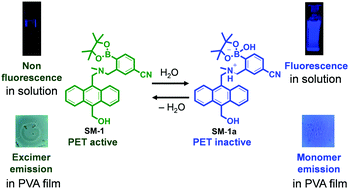Development of highly sensitive fluorescent sensor and fluorescent sensor-doped polymer films for trace amounts of water based on photo-induced electron transfer†
Abstract
Anthracene-(aminomethyl)phenylboronic acid pinacol ester (AminoMePhenylBPin) SM-1 having a cyano group as an electron-withdrawing substituent and a hydroxymethyl group has been developed as a highly sensitive PET (photo-induced electron transfer)-type fluorescent sensor for visualization, detection, and quantification of trace amounts of water. SM-1 shows enhancement of fluorescence with the increase in water content in various solvents (polar, less polar, protic, and aprotic solvents), which is attributed to the suppression of PET due to the formation of the PET inactive (fluorescent) species SM-1a by interaction with water molecules. In fact, the formation of SM-1a by interaction with water molecules has been successfully detected by 1H NMR spectral measurements. The detection limits (DLs) and quantitation limits (QLs) of SM-1 for water in solvents are, respectively, 0.006 and 0.018 wt% in 1,4-dioxane, 0.004 and 0.012 wt% in THF, 0.004 and 0.013 wt% in acetonitrile, and 0.007 and 0.021 wt% in ethanol, which are superior to those of OF-2 without a hydroxymethyl group. This result is attributed to the improvement of fluorescence emission properties by the introduction of a hydroxymethyl group to an anthracene fluorophore. Actually, fluorescence quantum yields (Φfl) of OF-2 and SM-1 in absolute acetonitrile are below 2%, but in acetonitrile with 1 wt% water content the Φfl of SM-1 (20%) is higher than that of OF-2 (13%). Moreover, we have achieved the preparation of various types of polymer films (polystyrene (PS), poly(4-vinylphenol) (PVP), polyvinyl alcohol (PVA), and polyethylene glycol (PEG)) doped with SM-1, and investigated the optical sensing properties of the SM-1-doped polymer films for water. It was found that the SM-1-doped polymer films produce a reversible switching in fluorescence color between the green excimer emission in the PET active state under a drying process and the blue monomer emission in the PET inactive state upon exposure to moisture. Herein, we propose that PET-type fluorescent sensor-doped polymer films based on a fluorescence enhancement system are one of the most promising and convenient functional materials for not only environmental and quality control monitoring systems and industry, but also visualizing the droplet on material surfaces.



 Please wait while we load your content...
Please wait while we load your content...